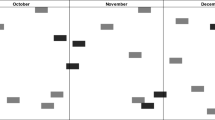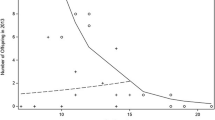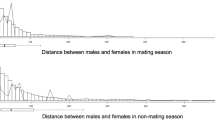Abstract
In groups with multiple males, direct mate competition may select for the evolution of dominance hierarchies that sort males into a queue for access to fertile females. The priority-of-access (PoA) model proposed by Altmann in 1962 makes explicit predictions about the resulting paternity distribution based on an interaction between male dominance rank and the overlap of female receptive phases. Here, we investigated whether the logic of the PoA model predicted the distribution of paternity across ranks in a seasonal breeder with high reproductive synchrony over six consecutive mating seasons. We studied 18 males that resided in a group of wild Assamese macaques (Macaca assamensis) in their natural habitat at Phu Khieo Wildlife Sanctuary, Thailand, between 2006 and 2011 with 5 to 13 conceptions per season. We assessed whether mate guarding increased paternity success, described “short-term” deviations from predicted paternity distribution, and examined how these are related to the number of competitors and fertile females. We determined genetic paternity of 43 (93 %) offspring born into the study group and found reproductive skew to be relatively low with 29 % alpha male paternity in accordance with the high degree of female reproductive synchrony observed. Short-term deviations from expected paternity distribution over ranks were not explained by the number of resident males or the number of conceiving females or their interaction. Within the limits of this study, these results suggest that even if males cannot discern female fertile phases, if reproduction is seasonal, and if reproductive synchrony is high, males may also compete directly over access to females.


Similar content being viewed by others
References
Alberts SC (2012) Magnitude and sources of variation in male reproductive performance. In: Mitani JC, Call J, Kappeler PM, Palombit RA, Silk J (eds) Evolution of primate societies. University of Chicago Press, Chicago, pp 412–431
Alberts SC, Altmann J, Wilson ML (1996) Mate guarding constrains foraging activity of male baboons. Anim Behav 51:1269–1277
Alberts SC, Heather EW, Altmann J (2003) Queuing and queue-jumping: long-term patterns of reproductive skew among male savannah baboons. Anim Behav 65:821–840
Alberts SC, Buchan JC, Altmann J (2006) Sexual selection in wild baboons: from mating opportunities to paternity success. Anim Behav 72:1177–1196
Altmann SA (1962) A field study of the sociobiology of rhesus monkeys, Macaca mulatta. Ann N Y Acad Sci 102:338–435
Altmann J (1974) Observational study of behavior: sampling methods. Behaviour 49:227–267
Arandjelovic M, Guschanski K, Schubert G, Harris TR, Thalmann O, Siedel H, Vigilant L (2009) Two-step multiplex PCR improves the speed and accuracy of genotyping using DNA from noninvasive and museum samples. Mol Ecol Resour 9:28–36
Baayen HR (2008) Analyzing linguistic data: a practical introduction to statistics using R. Cambridge University Press, Cambridge
Baayen RH (2010) language4: Data sets and functions with “Analyzing Linguistic Data: a practical introduction to statistics” http://CRAN.R-project.org/package=language4
Bates D, Maechler M, Bolker B (2012) lme4: linear mixed effects models using S4 classes. In: R package version 0.999999-0. http://CRAN.R-project.org/package=lme4
Bercovitch FB (1986) Male rank and reproductive activity in savannah baboons. Int J Primatol 7:533–550
Bissonnette A, Bischofberger N, van Schaik C (2011) Mating skew in Barbary macaque males: the role of female mating synchrony, female behavior, and male–male coalitions. Behav Ecol Sociobiol 65:167–182
Bissonnette A, Franz M, Schülke O, Ostner J (2014) Socioecology, but nor cognition, predicts male coalitions across primates. Behav Ecol (in press)
Boesch C, Kohou G, Nene H, Vigilant L (2006) Male competition and paternity in wild chimpanzees of the Taï forest. Am J Phys Anthropol 130:103–115
Bolker BM, Brooks ME, Clark CJ, Geange SW, Poulsen JR, Stevens MHH, White J-SS (2009) Generalized linear mixed models: a practical guide for ecology and evolution. Trends Ecol Evol 24:127–135
Borries C, Larney E, Kreetiyutanont K, Koenig A (2002) The diurnal primate community in a dry evergreen forest in Phu Khieo Wildlife Sanctuary, Northeast Thailand. Nat Hist Bull Siam Soc 50:75–88
Bowerman B, O’Connell R (1990) Linear statistical models: an applied approach, 2nd edn. Duxbury, Belmont
Boyko RH, Marshall AJ (2009) The willing cuckold: optimal paternity allocation, infanticide and male reproductive strategies in mammals. Anim Behav 77:1397–1407
Charpentier M, Peignot P, Hossaert-McKey M, Gimenez O, Setchell JM, Wickings EJ (2005) Constraints on control: factors influencing reproductive success in male mandrills (Mandrillus sphinx). Behav Ecol 16:614–623
Clutton-Brock TH (1998) Reproductive skew, concessions and limited control. Trends Ecol Evol 13:288–292
Clutton-Brock TH, Parker GA (1992) Potential reproductive rates and the operation of sexual selection. Q Rev Biol 67:437–456
Clutton-Brock TH, Vincent ACJ (1991) Sexual selection and the potential reproductive rates of males and females. Nature 351:58–60
Cowlishaw G, Dunbar RIM (1991) Dominance rank and mating success in male primates. Anim Behav 41:1045–1056
Csilléry K, Johnson T, Beraldi D, Clutton-Brock T, Coltman D, Hansson B, Spong G, Pemberton JM (2006) Performance of marker-based relatedness estimators in natural populations of outbred vertebrates. Genetics 173:2091–2101
de Ruiter JR, Scheffrahn W, Trommelen GJJM, Uitterlinden AG, Martin RD, van Hoof JARAM (1992) Male social rank and reproductive success in wild long-tailed macaques. In: Martin RD, Dixson AF, Wickings EJ (eds) Paternity in primates: genetic tests and theories. Karger, Basel, pp 175–191
de Vries H, Stevens J, Vervaecke H (2006) Measuring and testing the steepness of dominance hierarchies. Anim Behav 71:585–592
Dubuc C, Muniz L, Heistermann M, Engelhardt A, Widdig A (2011) Testing the priority-of-access model in a seasonally breeding primate species. Behav Ecol Sociobiol 65:1615–1627
Duffy KG, Wrangham RW, Silk JB (2007) Male chimpanzees exchange political support for mating opportunities. Curr Biol 17:R586–R587
Eberhardt WG (1996) Female control: sexual selection by cryptic female choice. Princeton University Press, Princeton
Ellis L (1995) Dominance and reproductive success among non-human animals: a cross-species comparison. Ethol Sociobiol 16:257–333
Emlen ST, Oring LW (1977) Ecology, sexual selection, and the evolution of mating systems. Science 197:215–223
Engelhardt A, Heistermann M, Hodges JK, Nurnberg P, Niemitz C (2006) Determinants of male reproductive success in wild long-tailed macaques (Macaca fascicularis)—male monopolisation, male mate choice or post-copulatory mechanisms? Behav Ecol Sociobiol 59:740–752
Engh AL, Funk SM, van Horn RC, Scribner KT, Bruford MW, Libants S, Szykman M, Smale L, Holekamp KE (2002) Reproductive skew among males in a female-dominated mammalian society. Behav Ecol 13:193–200
Fox J, Weisberg HS (2010) An R companion to applied regression. Sage, Thousand Oaks
Franz M, van der Post D, Schülke O, Ostner J (2011) The evolution of cooperative turn-taking in animal conflict. BMC Evol Biol 11:323
Fürtbauer I, Schülke O, Heistermann M, Ostner J (2010) Reproductive and life history parameters of wild female Macaca assamensis. Int J Primatol 31:501–517
Fürtbauer I, Heistermann M, Schülke O, Ostner J (2011) Concealed fertility and extended female sexuality in a non-human primate (Macaca assamensis). PLoS ONE 6:e23105
Fürtbauer I, Heistermann M, Schülke O, Ostner J (2013) Female fecal androgens prior to the mating season reflect readiness to conceive in reproductively quiescent wild macaques. Am J Phys Anthropol 151:311–315
Gogarten JF, Koenig A (2012) Reproductive seasonality is a poor predictor of receptive synchrony and male reproductive skew among nonhuman primates. Behav Ecol Sociobiol 67:123–134
Goudet J (1995) FSTAT (Version 1.2): a computer program to calculate F-statistics. J Hered 86:485–486
Henzi SP, Clarke PMR, van Schaik CP, Pradhan GR, Barrett L (2010) Infanticide and reproductive restraint in a polygynous social mammal. Proc Natl Acad Sci U S A 107:2130–2135
Heesen M, Rogahn S, Ostner J, Schülke O (2013) Food abundance affects energy intake and reproduction in frugivorous female Assamese macaques. Behav Ecol Sociobiol 67:1053–1066
Higham JP, Maestripieri D (2010) Revolutionary coalitions in male rhesus macaques. Behaviour 147:1889–1908
Higham JP, Heistermann M, Maestripieri D (2011) The energetics of male–male endurance rivalry in free-ranging rhesus macaques, Macaca mulatta. Anim Behav 81:1001–1007
Johnstone RA (2000) Models of reproductive skew: a review and synthesis. Ethology 106:5–26
Kuester J, Paul A (1992) Influence of male competition and female mate choice on male mating success in Barbary macaques (Macaca sylvanus). Behaviour 120:192–217
Kulik L, Muniz L, Mundry R, Widdig A (2011) Patterns of intervention and the effect of coalitions and sociality on male fitness. Mol Ecol 21:699–714
Kumsuk M, Kreetiyutanont K, Suvannakorn V, Sanguanyat N (1999) Diversity of wildlife vertebrates in Phu Khieo Wildlife Sanctuary, Chaiyaphum Province. Phu Khieo Wildlife Sanctuary, Wildlife Conservation Division, Natural Resources Conservation Office, Royal Forest Department, Bangkok, p 124
Kutsukake N, Nunn CL (2006) Comparative tests of reproductive skew in male primates: the roles of demographic factors and incomplete control. Behav Ecol Sociobiol 60:695–706
Langergraber KE, Mitani JC, Watts DP, Vigilant L (2013) Male–female socio-spatial relationships and reproduction in wild chimpanzees. Behav Ecol Sociobiol 67:861–873
Majolo B, Lehmann J, de Bortoli VA, Schino G (2012) Fitness-related benefits of dominance in primates. Am J Phys Anthropol 147:652–660
Marshall TC, Slate J, Kruuk LEB, Pemberton JM (1998) Statistical confidence for likelihood-based paternity inference in natural populations. Mol Ecol 7:639–655
Martin P, Bateson P (1993) Measuring Behaviour. Cambridge University Press, Cambridge
Massen JJM, Overduin-de Vries AM, de Vos-Rouweler AJM, Sptuijt BM, Doxiadis GGM, Sterck EHM (2012) Male mating tactics in captive rhesus macaques (Macaca mulatta): the influence of dominance, markets and relationship quality. Int J Primatol 33:73–92
Mayers R (1990) Classical and modern regression with applications, 2nd edn. Duxbury, Boston
McLachlan RI, O’Donnell L, Meachem SJ, Stanton PG, de Kretser DM, Pratis K, Robertson DM (2002) Identification of specific sites of hormonal regulation of spermatogenesis in rats, mice, and man. Recent Prog Horm Res 57:149–179
McMillan CA (1989) Male age, dominance, and mating success among rhesus macaques. Am J Phys Anthropol 80:83–89
Møller AP, Birkhead TR (1991) Frequent copulations and mate guarding as alternative paternity guards. Behaviour 118:170–186
Morin PA, Chambers KE, Boesch C, Vigilant L (2001) Quantitative polymerase chain reaction analysis of DNA from noninvasive samples for accurate microsatellite genotyping of wild chimpanzees (Pan troglodytes verus). Mol Ecol 10:1835–1844
Muniz L, Perry S, Manson JH, Gilkenson H, Gros-Louis J, Vigilant L (2010) Male dominance and reproductive success in wild white-faced capuchins (Cebus capucinus) at Lomas Barbudal, Costa Rica. Am J Primatol 72:1118–1130
Nadler R (1994) Walter Heape and the issue of estrus in primates. Am J Primatol 33:83–87
Newton-Fisher NE, Thompson ME, Reynolds V, Boesch C, Vigilant L (2010) Paternity and social rank in wild chimpanzees (Pan troglodytes) from the Budongo Forest, Uganda. Am J Phys Anthropol 142:417–428
Noë R, Sluijter AA (1990) Reproductive tactics of male savanna baboons. Behaviour 113:117–170
Nonacs P (2000) Measuring and using skew in the study of social behavior and evolution. Am Nat 156:577–589
Nonacs P (2003) Measuring the reliability of skew indices: is there one best index? Anim Behav 65:615–627
Nsubuga AM, Robbins MM, Roeder A, Morin PA, Boesch C, Vigilant L (2004) Factors affecting the amount of genomic DNA extracted from ape feces and the identification of an improved sample storage method. Mol Ecol 13:2089–2094
Ostner J, Schülke O (2014) The evolution of social bonds in primate males. Behaviour (published online, doi:10.1163/1568539X-00003191)
Ostner J, Nunn CL, Schülke O (2008a) Female reproductive synchrony predicts skewed paternity across primates. Behav Ecol 19:1150–1158
Ostner J, Heistermann M, Schülke O (2008b) Dominance, aggression and physiological stress in wild male Assamese macaques (Macaca assamensis). Horm Behav 54:613–619
Ostner J, Heistermann M, Schülke O (2011) Male competition and its hormonal correlates in Assamese macaques (Macaca assamensis). Horm Behav 59:105–113
Ostner J, Vigilant L, Bhagavatula J, Franz M, Schülke O (2013) Stable heterosexual associations in a promiscuous primate. Anim Behav 86:623–631
Overduin-de Vries AM, Olesen CU, Vries H, Spruijt BM, Sterck EHM (2012) Sneak copulations in long-tailed macaques (Macaca fascicularis): no evidence for tactical deception. Behav Ecol Sociobiol 67:101–111
Pandit S, van Schaik CP (2003) A model for leveling coalitions among primate males: toward a theory of egalitarianism. Behav Ecol Sociobiol 55:161–168
Port M, Kappeler PM (2010) The utility of reproductive skew models in the study of male primates, a critical evaluation. Evol Anthropol 19:46–56
R Development Core Team. 2012 R: A language and environment for statistical computing. Vienna, Austria. http://www.R-project.org/, R Foundation for Statistical Computing
Rodriguez-Llanes JM, Verbeke G, Finlayson C (2009) Reproductive benefits of high social status in male macaques (Macaca). Anim Behav 78:643–649
Say L, Pontier D, Natoli E (2001) Influence of oestrus synchronization on male reproductive success in the domestic cat (Felis catus L.). Proc R Soc Lond B 268:1049–1053
Schielzeth H, Forstmeier W (2009) Conclusions beyond support: overconfident estimates in mixed models. Behav Ecol 20:416–420
Schülke O, Bhagavatula J, Vigilant L, Ostner J (2010) Social bonds enhance reproductive success in male macaques. Curr Biol 20:2207–2210
Schülke O, Heistermann M, Ostner J (2014) Lack of evidence for energetic costs of mate-guarding in wild male Assamese macaques (Macaca assamensis). Int J Primatol. doi:10.1007/s10764-013-9748-y
Setchell J, Charpentier M, Wickings EJ (2005) Mate guarding and paternity in mandrills: factors influencing alpha male monopoly. Anim Behav 70:1105–1120
Sharpe RM (1994) Regulation of spermatogenesis. In: Knobil E, Neil JD (eds) The physiology of reproduction. Raven Press, New York, pp 1363–1434
Snyder-Mackler N, Alberts S, Bergman BJ (2012) Concessions of an alpha male? Cooperative defense and shared paternity in multi-male primate groups. Proc R Soc Lond B 279:3788–3795
Soltis J, Thomsen R, Takenaka O (2001) The interaction of male and female reproductive strategies and paternity in wild Japanese macaques, Macaca fuscata. Anim Behav 62:485–494
Stockley P (2004) Sperm competition in mammals. Hum Fertil 7:91–97
Stumpf RM, Boesch C (2006) The efficacy of female choice in chimpanzees of the Taï Forest, Côte d’Ivoire. Behav Ecol Sociobiol 60:749–765
Tourmente M, Gomendio M, Roldan ERS (2006) Sperm competition and the evolution of sperm design in mammals. BMC Evol Biol 11:12
Trivers RL (1972) Parental investment and sexual selection. In: Campbell B (ed) Sexual selection and the descent of man, 1871-1971. Aldine-Atherton, Chicago, pp 136–179
van Horn RC, Altmann J, Alberts S (2008) Can’t get there from here: inferring kinship from pairwise genetic relatedness. Anim Behav 75:1173–1180
Widdig A, Bercovitch FB, Streich WJ, Sauermann U, Nurnberg P, Krawczak M (2004) A longitudinal analysis of reproductive skew in male rhesus macaques. Proc R Soc Lond B 271:819–826
Willisch CS, Neuhaus P (2010) Social dominance and conflict reduction in rutting male Alpine ibex, Capra ibex. Behav Ecol 21:372–380
Wroblewski EE, Murray CM, Keele BF, Schumacher-Stankey JC, Hahn BH, Pusey A (2009) Male dominance rank and reproductive success in chimpanzees, Pan troglodytes schweinfurthii. Anim Behav 77:873–885
Young C, Hähndel S, Majolo B, Schülke O, Ostner J (2013) Male coalitions, dominance rank and female preferences independently affect male mating success in wild Barbary macaques. Behav Ecol Sociobiol 67:1665–1677
Young C, Schülke O, Ostner J (2014) How males form coalitions against group rivals and the Pandit/van Schaik coalition model. Behaviour. (published online, doi:10.1163/1568539X-00003166)
Acknowledgments
We thank the National Research Council of Thailand (NRCT) and the Department of National Parks, Wildlife and Plant Conservation (DNP) for the permission to conduct this study and for all the support granted. We are grateful to Kitti Kreetiyutanont, Mongkul Kumsuk, Kanjana Nitaya, and Jarupol Prabnasuk (Phu Khieo Wildlife Sanctuary) for their cooperation and permission to carry out this study. We thank A. Koenig and C. Borries (Stony Brook University), who developed the field site at Huai Mai Sot Yai. We thank D. Bootros, N. Bualeng, A. Chunchaen, I. Fürtbauer, M. Heesen, R. Intalo, N. Juntuch, S. Jumrudwong, M. Karlstetter, Thipusa Kilawit, Sally MacDonald, W. Nueorngshiyos, D. Pesek, N. Ponganan, S. Rogahn, P. Saaisawasthikul, M. Swagemakers, B. Whitman, and T. Wisate for their excellent help in the field. We also thank N. Bhumpakphan, W. Eiadthong (Kasetsart University), and W. Brockelman (Mahidol University) for the support and cooperation. We would also like to thank the Faculty of Veterinary Medicine, Kasetsart University, Thailand. We are grateful to Linda Vigilant and Jojo Bhagavatula who established the paternity analyses for this study and thank Chris Young for the help with the statistical analyses. We thank Anja Widdig, Antje Engelhardt, and five anonymous reviewers for helpful comments on different versions of the manuscripts. This research was supported by the Max-Planck Society, the National Geographic Society, and the German Initiative of Excellence through funds to the University of Göttingen as well as by the Center of Excellence on Agricultural Biotechnology, Science and Technology Postgraduate Education and Research Development Office, Office of Higher Education Commission, Ministry of Education (AG-BIO/PERDO-CHE).
Ethical standards
This study was conducted completely noninvasively and under the permission of the authorities of Thailand, i.e., the National Research Council of Thailand (NRCT) and the Department of National Parks, Wildlife and Plant Conservation (DNP) (permits 0004.3/3618 and 0002.3/2647), and we adhered to the Guidelines of the Use of Animals in Research and the guidelines of the involved institutions.
Author information
Authors and Affiliations
Corresponding author
Additional information
Communicated by A. Widdig
Electronic supplementary material
Below is the link to the electronic supplementary material.
Supplementary Material Table 1
(DOC 49 kb)
Rights and permissions
About this article
Cite this article
Sukmak, M., Wajjwalku, W., Ostner, J. et al. Dominance rank, female reproductive synchrony, and male reproductive skew in wild Assamese macaques. Behav Ecol Sociobiol 68, 1097–1108 (2014). https://doi.org/10.1007/s00265-014-1721-z
Received:
Revised:
Accepted:
Published:
Issue Date:
DOI: https://doi.org/10.1007/s00265-014-1721-z




